RPG Plant Books: A Growing Genre
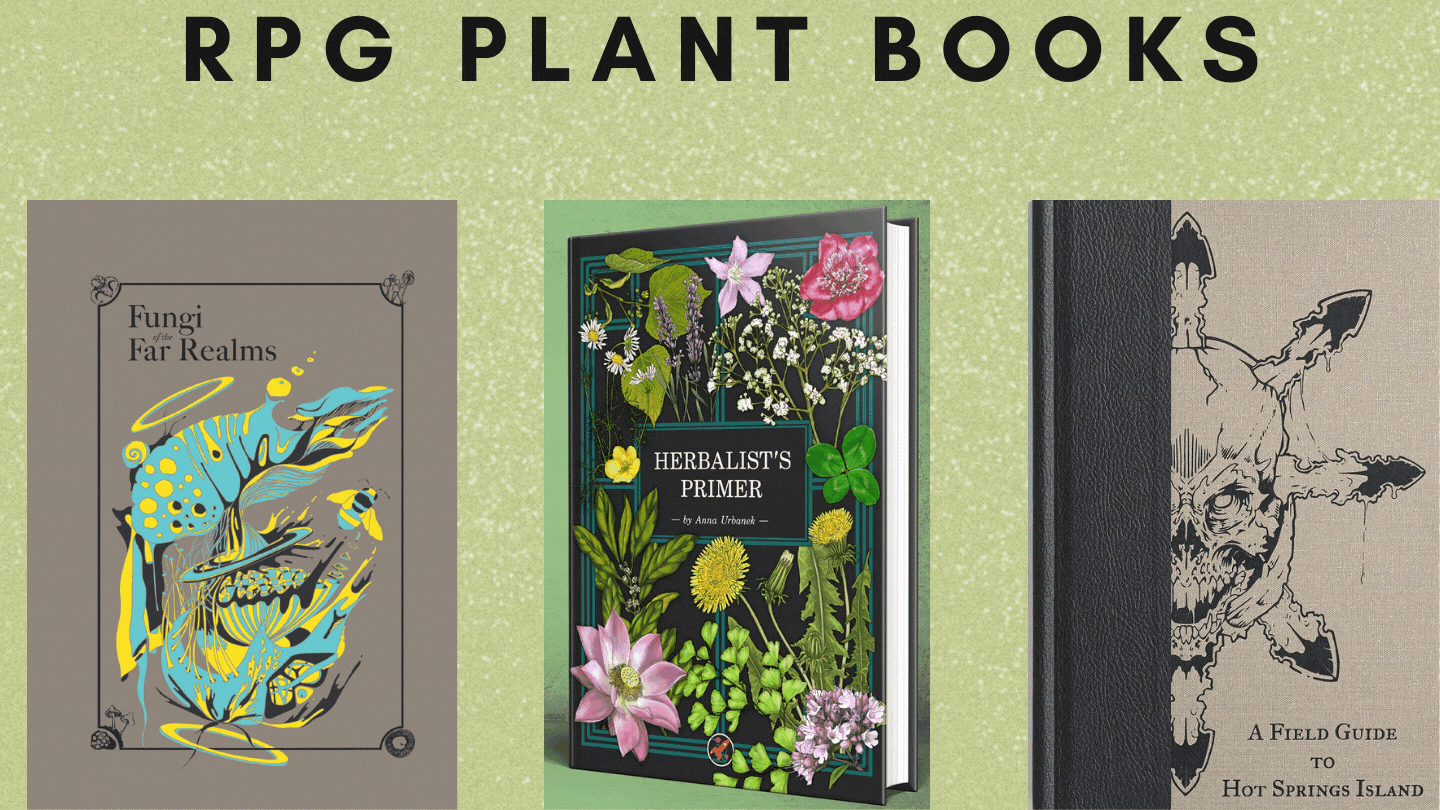
If you hated the pun in that title, then you should probably just leaf.
Today we’re going to take a look at plants in roleplaying games. With the announcement of the Herbalists Primer Kickstarter, it’s safe to say that a large audience exists; and they’re hungry for more!
So I called my mom, Heather (yes that’s her name, this isn’t a pun…I mean it IS a pun but it’s also real). She is a talented gardener and educator but has ZERO experience with RPGs (aside from trying to understand why people enjoy my weird books).
What follows is a series of interview questions about plants, games, stories, and dirt. Lots of dirt. We take a look at three books and examining their gardening and gaming potential.
Getting our Hands Dirty Permalink
David: From a gaming perspective, plants are often an afterthought. It’s only recently that I’ve considered their potential for stories and adventure. However, you learned the true joy of plants long ago! Tell me a little bit about why you enjoy gardening & what kinds of plants you grow.
Heather: I love planting a package of seeds, and watching the little guys grow. It’s like having kids without mouths. And you can eat them. (Some of them. Is that too dark?) At first, I tried growing lots of veggies, but they didn’t do too well. Then I realized, Hey! I’m gonna buy vegetables but I usually don’t buy flowers. With a 25 cent pack of seeds from the dollar store, I have fun for several weeks and end up with flowers. Win-win.
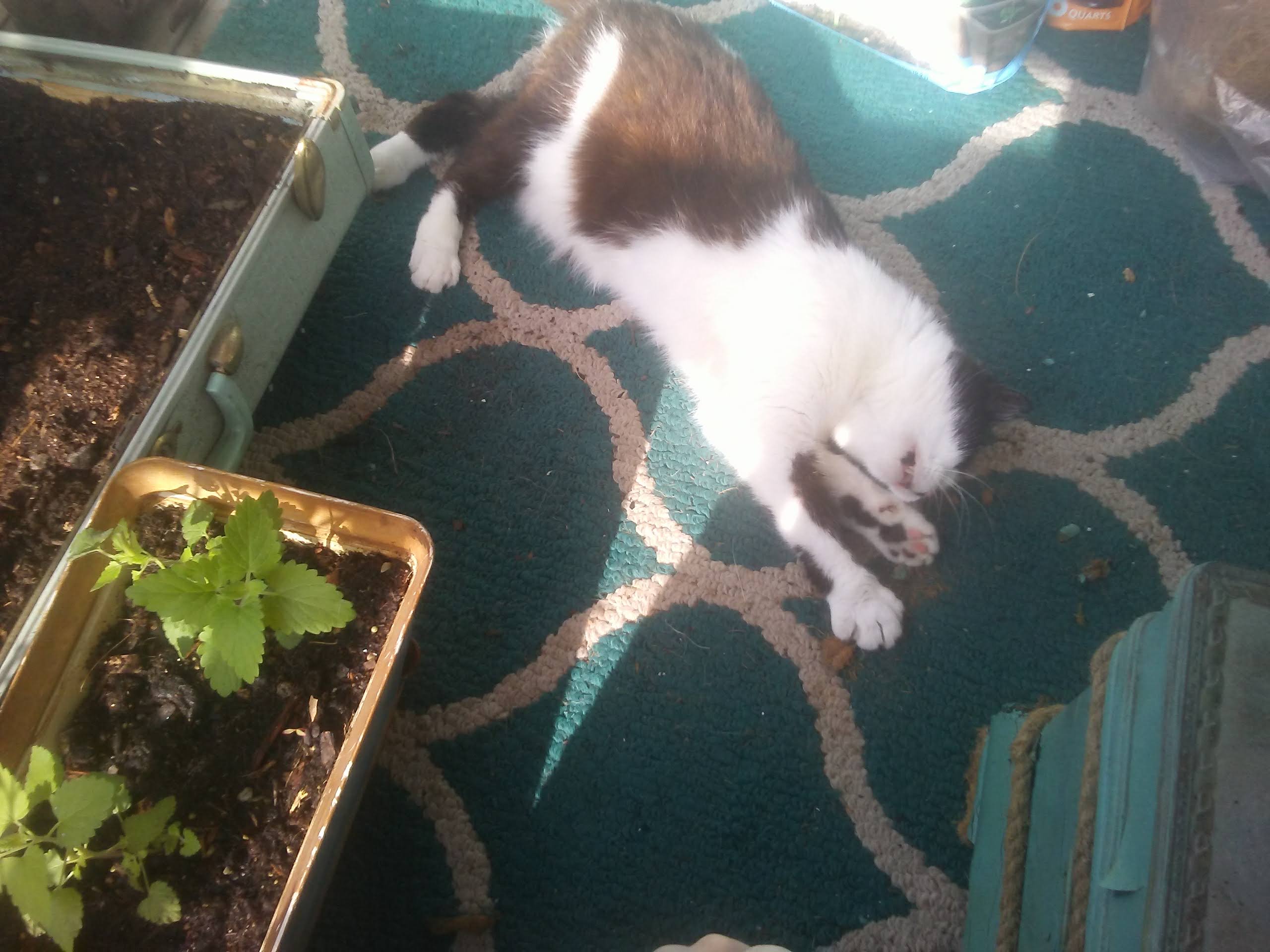 When I asked her for a headshot, she sent me this. This is Patchie, her most beloved child. Excluding me, of course. And my sister too, I guess.
When I asked her for a headshot, she sent me this. This is Patchie, her most beloved child. Excluding me, of course. And my sister too, I guess.
David: Nerds tend to flock together; are gardeners the same? What communities are you involved in?
Heather: I’m part of the Lowcountry Plant Swap on Facebook. “No sales, just swaps.” People have a wild variety of plants, love sharing them and talking about them. Last summer I swapped for a goldfish plant. (so cool.) I went to an in-person plant swap and picked up some bamboo, two tall cacti called African Milk Trees (aka Euphorbia Trigona). And a wheelbarrow! My Mini Cooper was full up and we had to put the three bamboo trees in your convertible. What a fun ride you all had!
Editor’s Note: It was not fun. Convertibles do not make good tree transports.
David: What gets you excited about a new plant?
Heather: I like figuring out what they need to germinate, how much sun and water they need, what kind of soil they like. I love it when they flower, and if a fruit or veggie follows the flower, it’s over the top!
David: If I used the term ‘adventure’ with regards to plants, what’s the first thing that comes to mind? Why?
Heather: Getting a new package of seeds or a new seedling, figuring out which pot or spot to put it in. It would be amazing if there were a plant backpack like the cat backpack and you could actually take a plant on an adventure.
David: What books about plants do you own? What do you look for in a gardening book?
Heather: I have a book about lasagna gardening: planting in layers, depending on how much soil is needed above and below, how long they need to sit in the soil, how long it takes to produce. I also have a book about fairy garden plants. That is a whole ‘nother story. Love the gnomes and fairy garden cuties! I do almost all my research and reading online. So easy, so detailed, and the comments are usually interesting or funny.
Garden Pics Permalink
Taking a moment to brag on my mom and show off her beautiful garden! The soil here is sandy, so she relies on a lot of pots and suitcases to allow her plants to thrive.
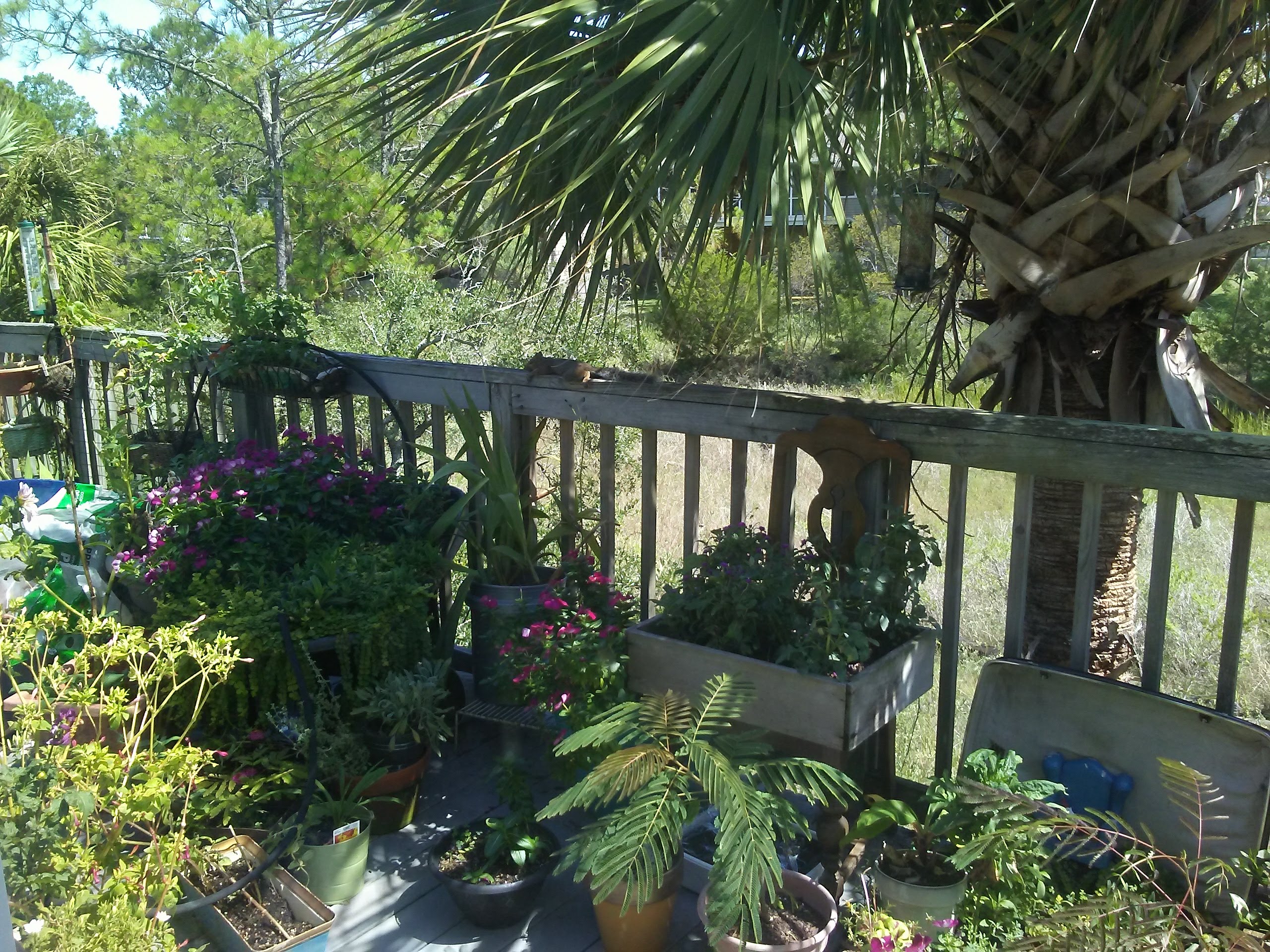 | 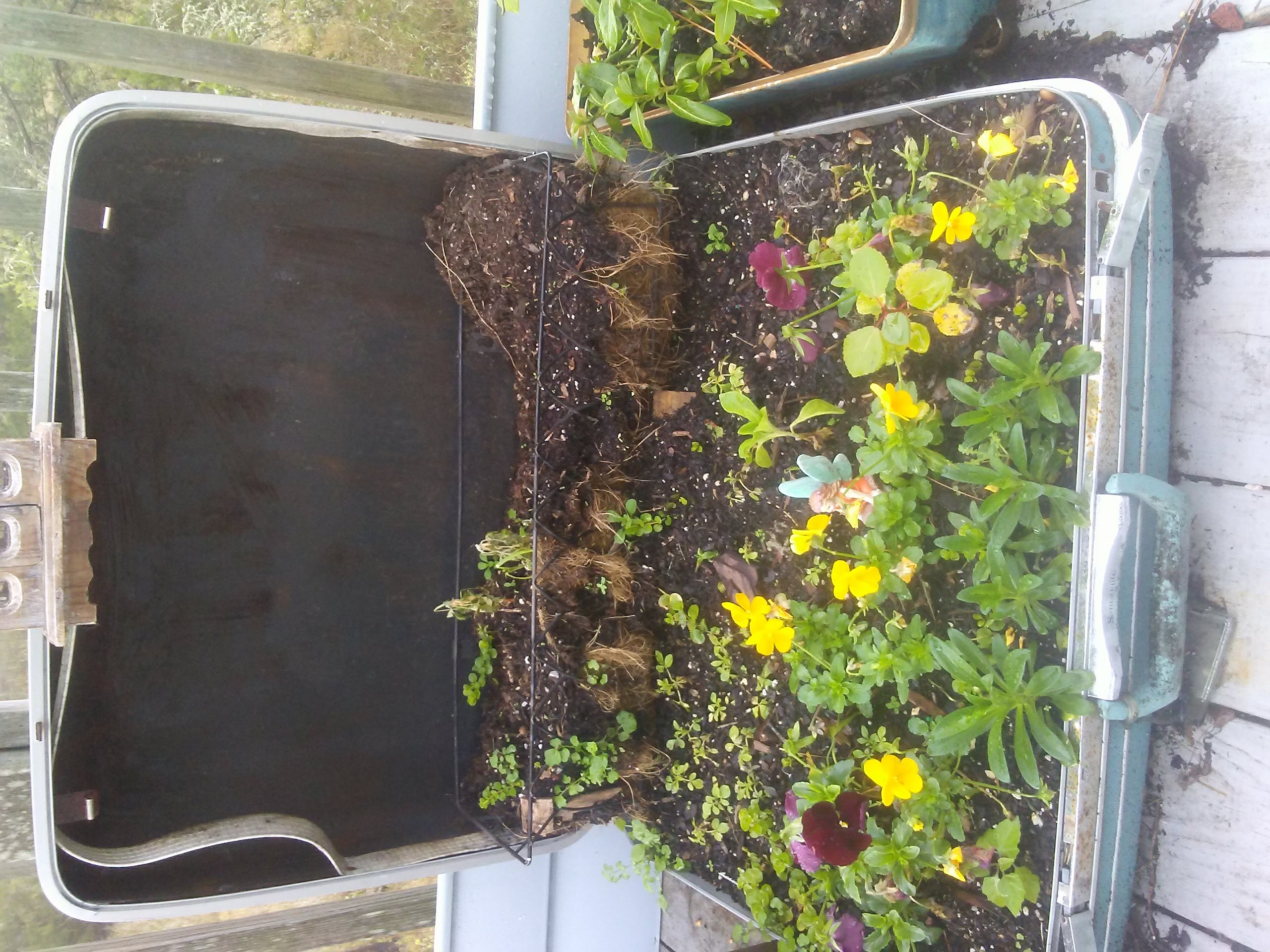 |
Also garden gnomes.
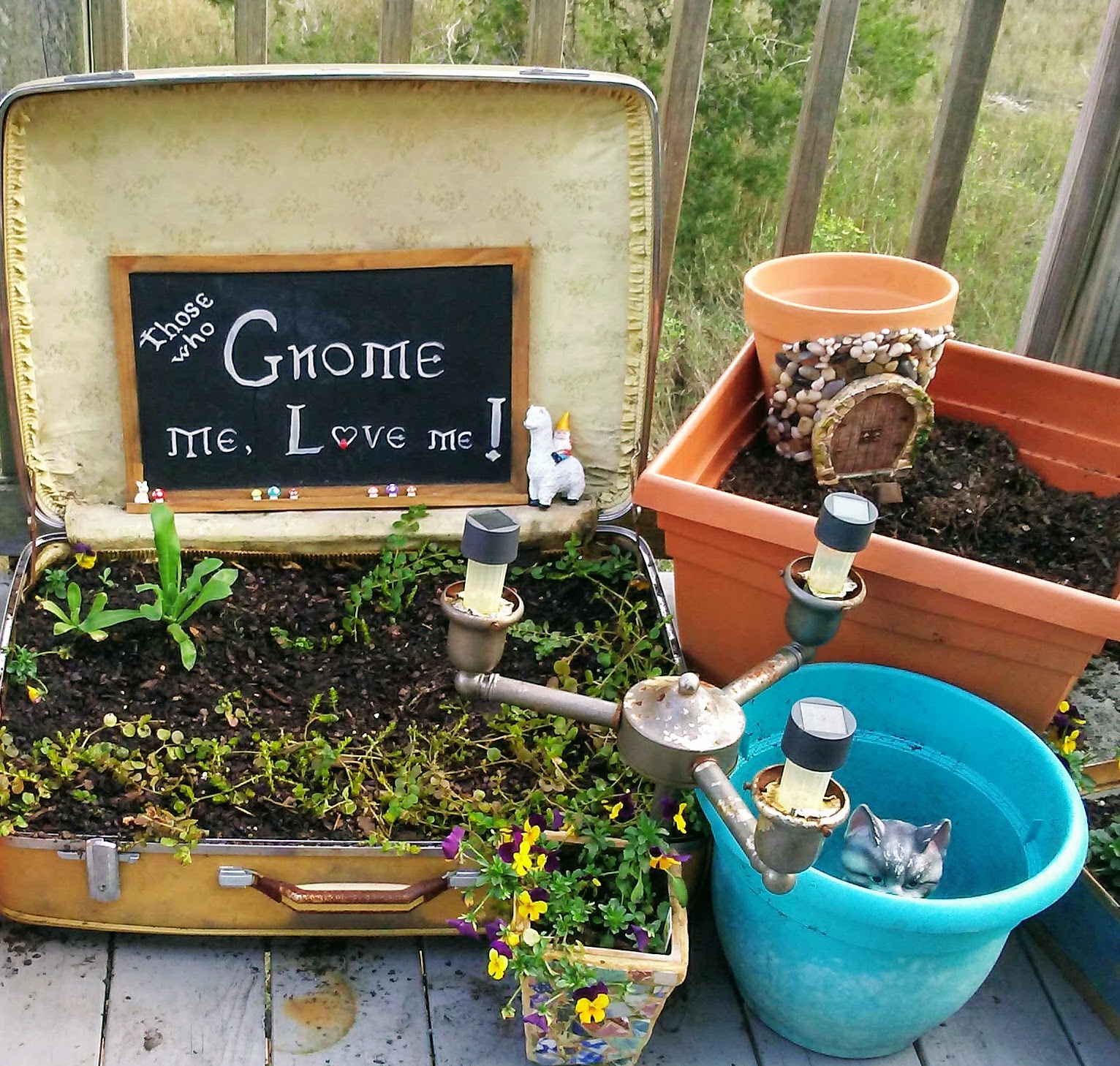 | 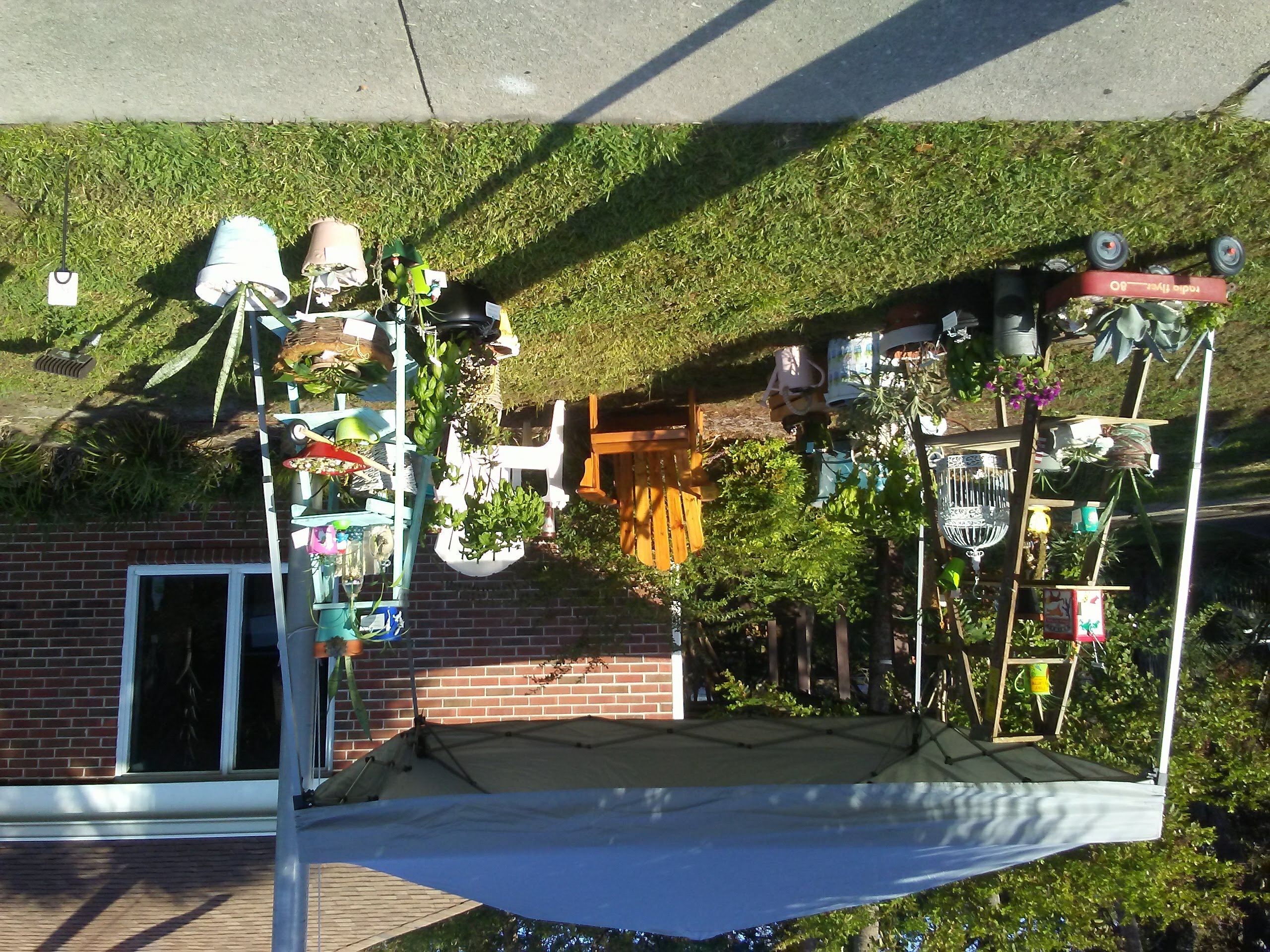 booth from a plant swap she recently attended booth from a plant swap she recently attended |
Anyway, back to the books!
The Books Permalink
Now we can steer the direction towards plants as RPG content. At this point I forced my mother to read three RPG plant books:
Mom is a writer; she understands what makes a good story. But she hasn’t delved very deeply into improv storytelling or roleplaying. (Note by mother: Except for participating in Extemporaneous Speech competitions in high school.)
I explained how RPGs rely on obstacles and rewards to drive the game forward. “This plant can cure any disease, but it has to be watered with liquid gold.” Ideally, a plant would act as a problem AND a reward. How can it be used? What are some of the challenges related to finding/growing this plant?
We’ll list specific examples from both books and general points or trends that we noticed.
Hot Springs Island Permalink
Hot Springs Island is one of my favorite games. I’ve reviewed it before. For those who don’t know, there is a GM guide (which looks like a traditional RPG text) and a Field Guide for the players. The Field Guide is filled with rumors, illustrations, and hints about surviving the island. In this case, my mother read through the Field Guide which has about 20 plants detailed within.
For my part, the plants within always played a minor role in games. Maybe they’d be mentioned as a bit of flavor, or to drive home how weird the island is. My players were usually more engaged by the creatures than the plants.
David: What did you think about the plants in Hot Springs Island?
Heather: Overall, it seemed like the plants were more about the setting than useful in play. Some had interesting details, and there were often backstories for the plants that gave more info and hinted at how it might be used in play.
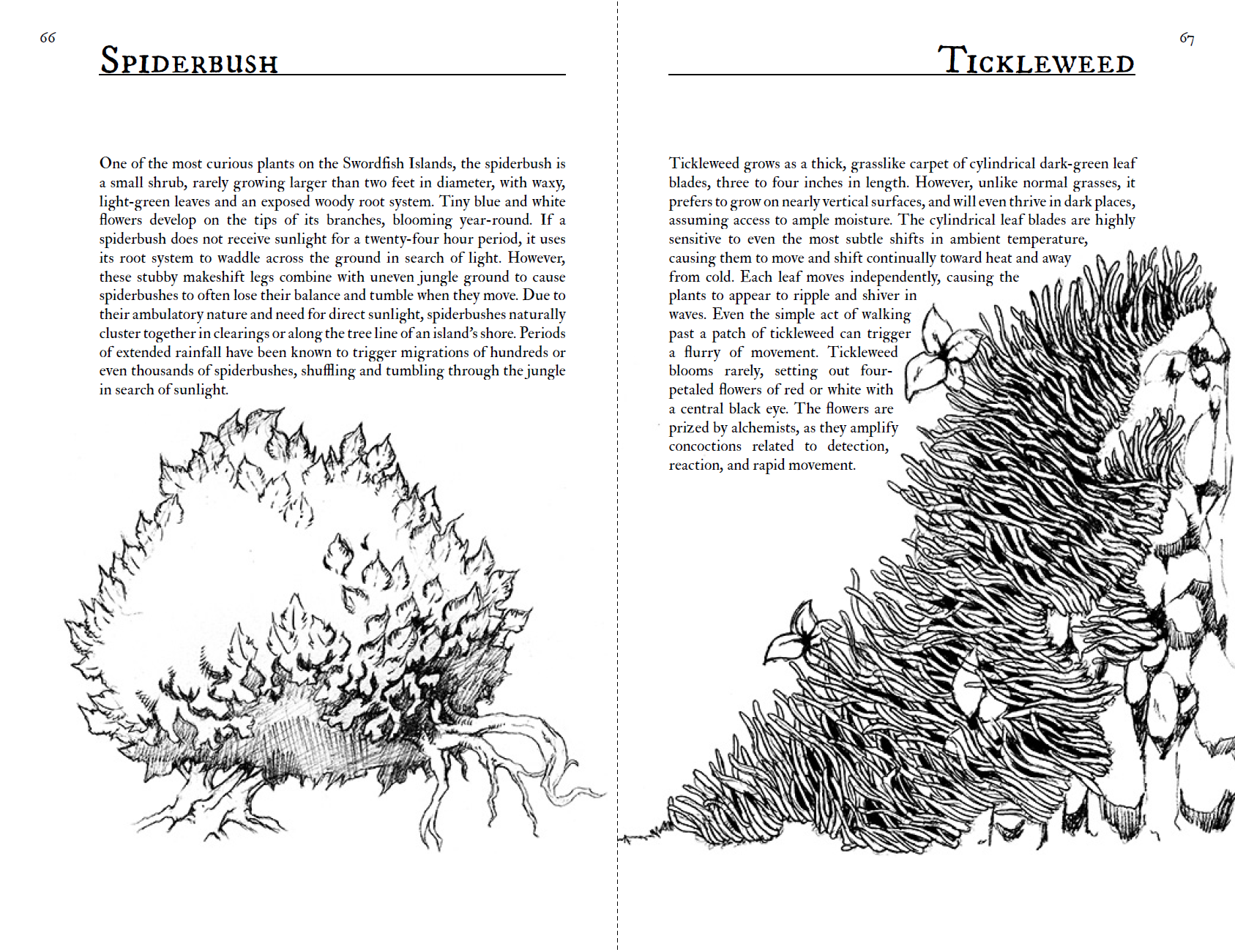
Here are some of her favorite examples:
- Fascinating: Ambermoss can cause aural hallucinations - “a deep, repetitive ‘wub wub wub’.” What? That’s crazy.
- Useful, especially in an RPG: Ashvein Tree - boil bark for 3 hours, “it completely neutralizes the flavor and odor of anything crushed with it.” Nice, if you wanted to cover the taste of bitter poison.
- Bizarre: Cave Lily - grows inside caves, on the ceiling. The roots are actually above the cave and get all the sun, soil, and moisture the flowers need to thrive.
- Interesting Element in a Game:
- Jelly Moss has unique qualities and causes division wherever it pops up. Might be a side effect players would not expect.
- Spiderbush tumbling around is creative.
- Like real plants (but different):
- Constrictor Vine - wraps around and pulls things into the ground, even trees and huge rocks. Reminds me of Morning Glories that vine around my other plants and pull them around.
- Ember Coral made me think of Moonflowers, related to Morning Glory.
- Flint Moss - Normal moss is very useful for starting a fire. Flint Moss has some added characteristics.
- Two plants are reminiscent of the Venus Fly Trap: Snapping Grass & Pygmy King Flower.
- Sleeping Ivy - Like poison ivy, but makes you sleep, not itch.
David: Were there any plants you wish were real? Would you grow them in your garden?
Heather: Rainbow Petals, aka color spikes, grow 4-8 feet tall on “deadly terminal spike.” One spike of rainbow petals can feed a human per day. That would be neat. I would also grow a few Spiderbushes under the house, maybe just out of the sun so they’d have to move around.
Even if the plants don’t intrigue you, the rest of the book is chock full of dungeons, creatures, factions, and dozens of interesting, organic quests for your players to explore.
Fungi of the Far Realms Permalink
I was provided a review copy of Fungi of the Far Realms by Spear Witch. I knew of the book and admired the gorgeous art from a distance. But I always thought to myself “how useful can a bunch of mushrooms really be?” It wasn’t something I pulled the trigger on…so I was grateful to receive a review copy and be proven wrong.
The book is 300+ pages of fantastical and weird mushrooms; each with a beautiful piece of art to accompany it. However when I handed it to my mother she tried to suppress a grimace.
Heather: Mushrooms? Ugh….I hate mushrooms. They’re gross and creepy.
However, a few days later we met for lunch and she surprised me by admitting that she enjoyed Fungi even more than the Hot Springs Field Guide.
Heather: “The more I read, the more impressed I was with how wildly creative and useful so many of these mushrooms would be! Some of them were still gross and creepy, but others were inspiring. I could see writing a story based on some of these.”
Some favorites:
- Babelfruit. Would have made teaching high school Spanish muuuch easier.
- Cartographer’s Inkcap. I like how it’s specifically for drawing weather-resistant maps. That’s a fun detail. Also, it grows on the beach!
- Mythic Dream Aminata. If you eat this in a dream, you find it in real life after you awake. What a neat idea! Dreams can contain a lot of truth, and it’s cool to see that reflected in a plant/fungi.
- Quebling Cathedral. So clever! It mirrors architecture and can be a way to reconstruct lost buildings.
Some particularly useful examples:
- Moonsponge. Glowing plants are always nice. I could use a few in my garden for evening work.
- Soapbar Bolete. After digging and sweating in the garden all day, this might be handy.
- Temperance Bracket. I don’t drink much, but I imagine folks would find this useful on a Monday morning.
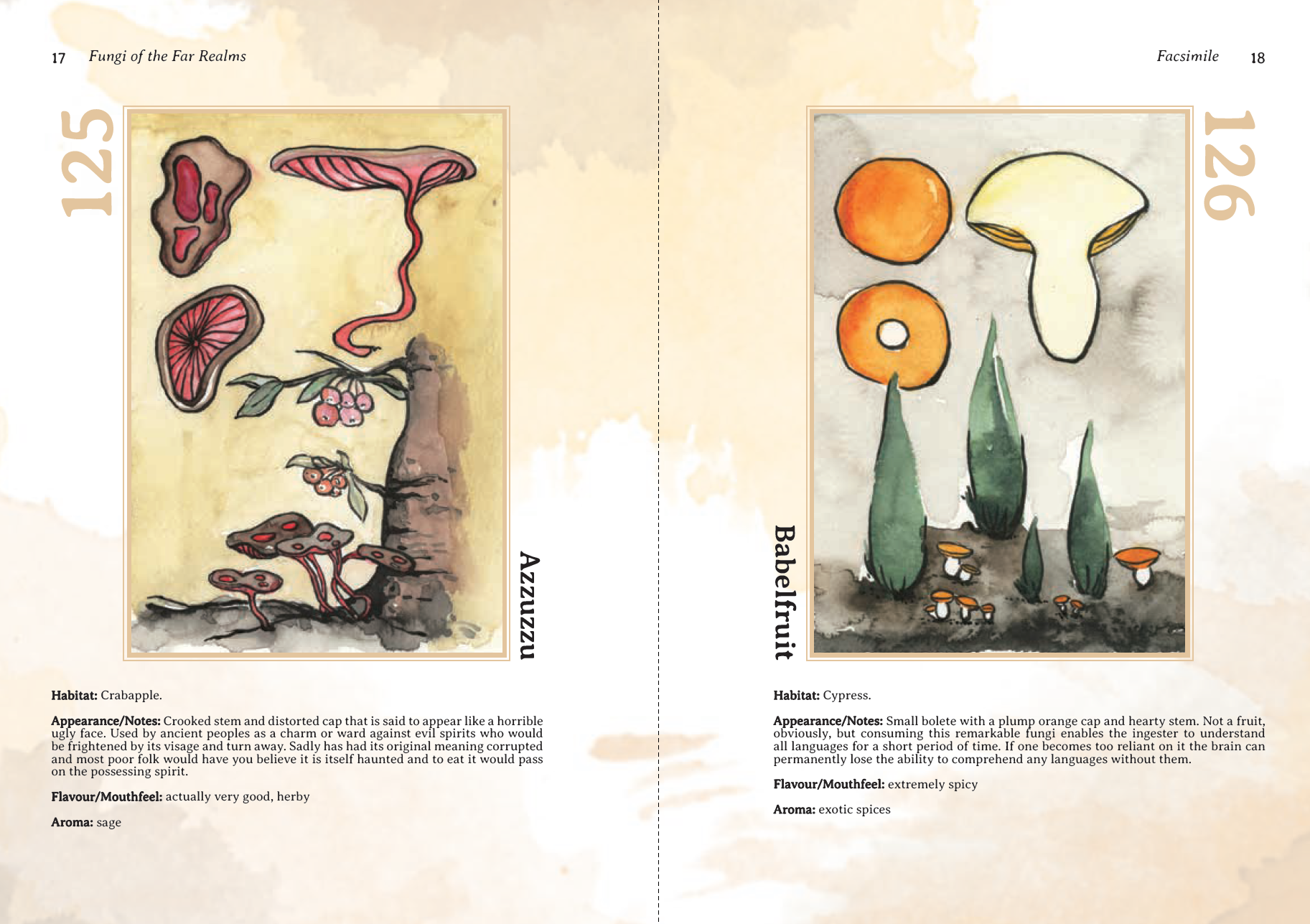
The creepiest examples:
- Cucco Aminata. Not only is the illustration disgusting, but it takes you over and FORCES you to protect it. shudders
- Devil’s Bargain. “Used as a currency in hell” kinda says it all.
Intriguing:
- Zarafetti’s Eyelash Fungus. I want to learn more about this philosopher who hated mushrooms but still got a mushroom named after him!
- Wise Man of the Moor. Mushrooms that act like a psychic mirror and give advice…clever (and weird)!
- Saddle of Harsh Judgment. If you have one, you’ve been accused of a murder by someone. How does that work? Why? Tell me more!
Cool Shrooms with lame names. Note that these examples are NOT a criticism of the author. Most plants have boring names (“Poison Ivy”, “Sunflower”, “Thornbush”, etc). Rather, the rest of the book is so imaginative and inspiring that we found these names to be…lacking.
- Farmer’s Friend. Useful barometer, and looks funky. Suggested names: Purple Sky, Stormcap, Rainfinder.
- Ginger Spike. Children eat it to try and turn their hair red. Suggested names: Firecap, Coppertop, Naive Redhead.
- The Green Man’s Gift. A rare mushroom that can sustain someone for years and years after they eat it. Suggested names: Eternal Meal, Final Dessert, Yellow Fullbelly.
- Hummingbird Mushroom. A floating multi-colored mushroom that looks more like a kite than a hummingbird. Suggested names: Kitecap, Rainbow Sail, Color Float.
- Hypermushroom. Hypothetically exists in other dimensions. Suggested Names: Theorem Amanita, Philosopher’s Stone, Calm Terror.
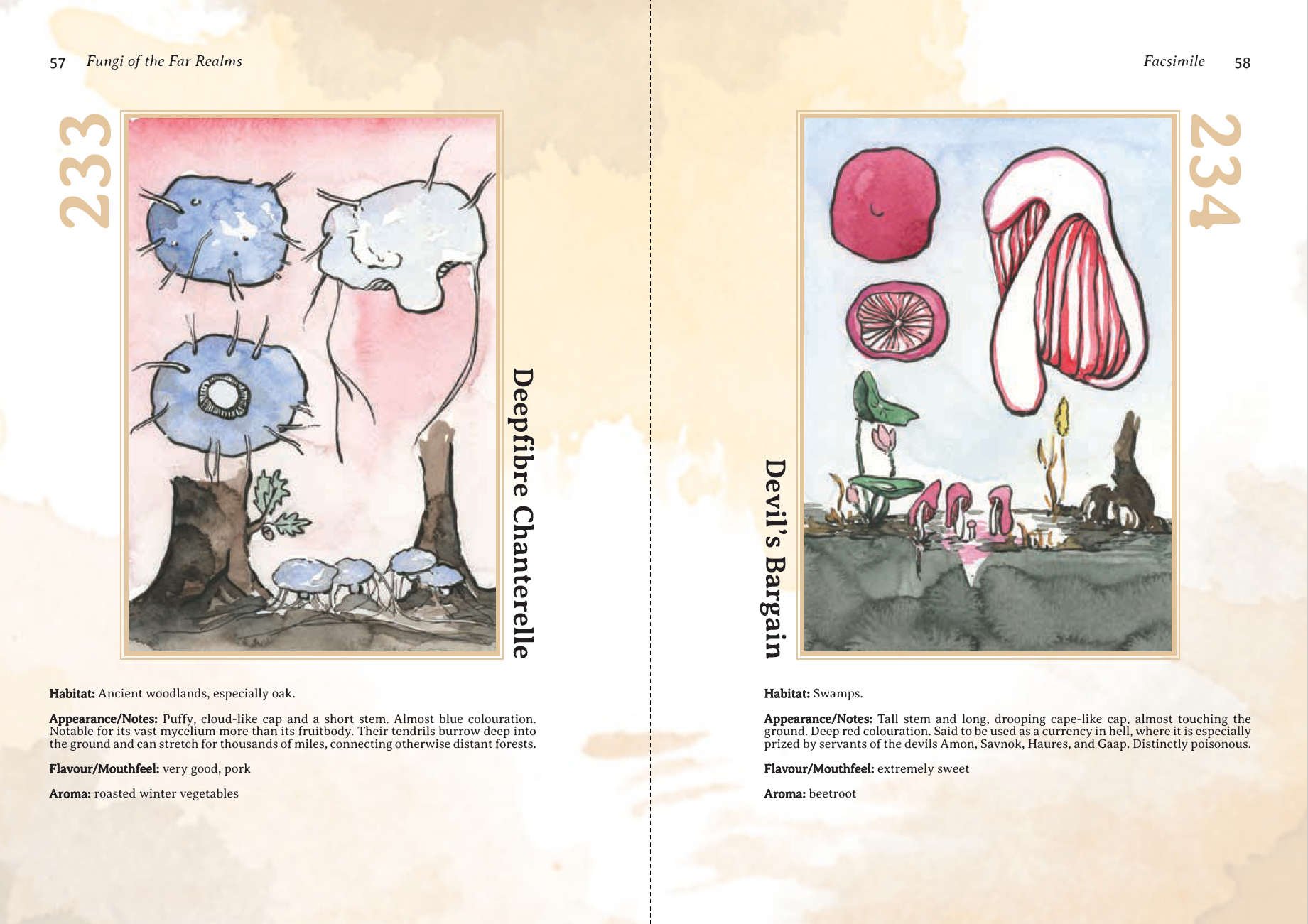
Amazing names! By contrast, we thought the names of these mushrooms were almost better than their description:
- Kraken Fungus. It consumes corpses, and entraps anything that gets too close. Creepy!
- Game Board Flatcap. Tiled hexes on a colorful cap. Sounds like a fairy tale.
Just…bizarre. We didn’t even know what to make of these:
- Moleman. Underground mushroom that sends tendrils up to feed on decomposing matter. There’s a detail about how it can consume sleeping travelers that’s just so bizarre.
- Screaming Tooth Fungus. When cut, it shrieks loudly. What?
- Shattering Brittlegill. Extremely fragile and disintegrates at the slightest touch.
- Plim. Says it has a “Plimmy” aroma. How does plimmy smell?
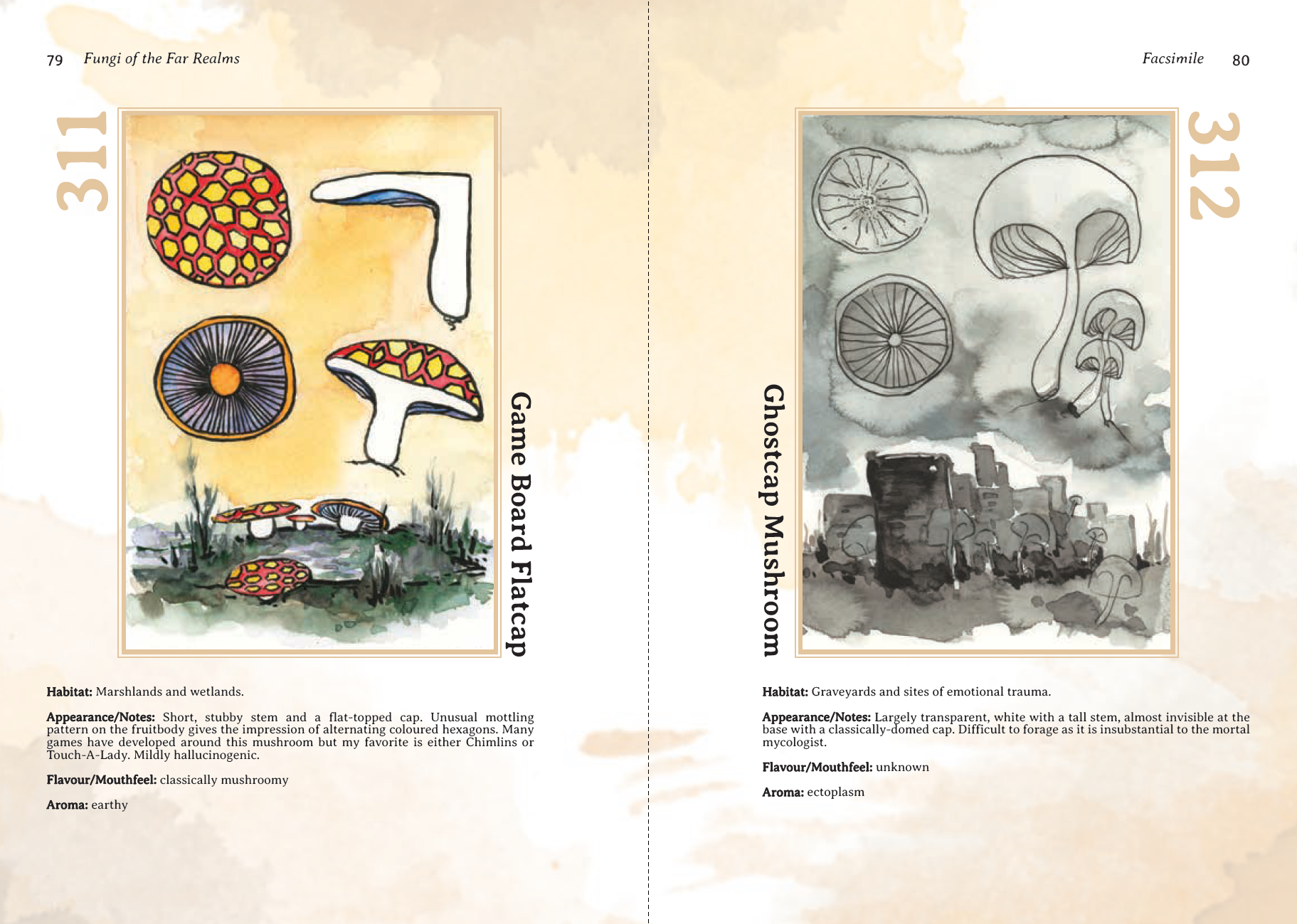
I (David) also read through the book and was impressed with the variety and creativity on display here. It’s hard to recommend as an “adventure” book. There are no quests or encounters or stats or anything like that in here. But there are dozens and dozens of unique ideas scattered around these mushrooms.
A creative GM who’s looking for inspiration for their own adventures would be hard-pressed to find a better book than Fungi of the Far Realms. My only hesitation is that there is “some assembly required” if you want this to hit your table and inspire a gaming session.
Herbalists Primer Permalink
Finally, we took a look at the Herbalists Primer Kickstarter Page. It’s been WILDLY successful, raising over $800,000!
The Primer is far more grounded in reality (but not fully). All of the plants included are from the real world but explained through the lens of science, legend, and mysticism. The sample includes a half dozen plants, some adventure seeds, and diagrams.
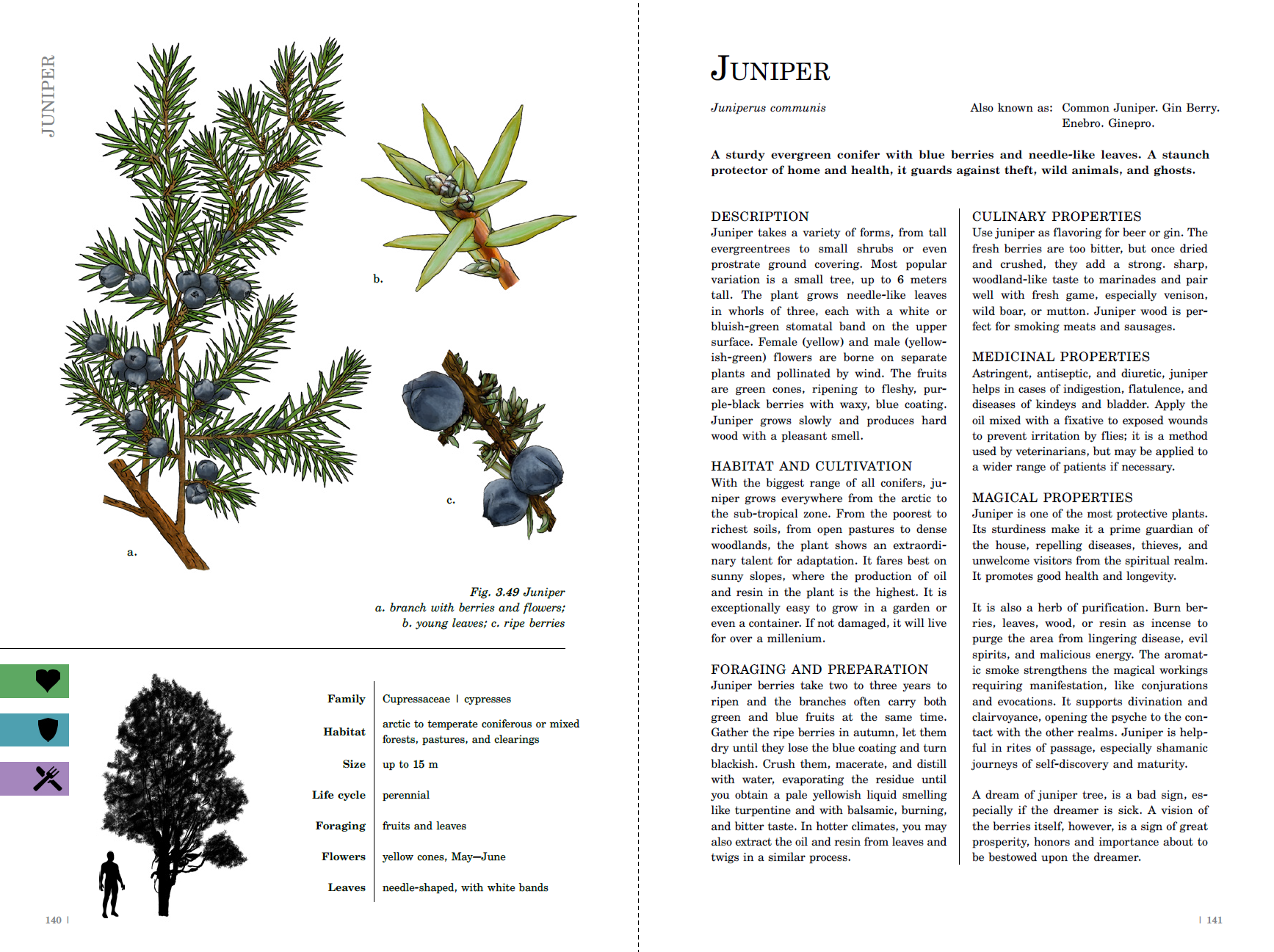
Heather: I recognize a few of these! Are these real plants? Oh, but they have so much extra detail. I love the history and cultural details. Also, this book actually talks about how to grow/nurture these plants. Fun!
David: Do you see anything magical or fantastical about the plants you work with? Have you been inspired by a real-world plant?
Heather: I have! Sometimes I see a plant and I get inspired and want to learn more about it. I’m thrilled with String of Dolphins (the cutest succulent in existence!). I also bought some plants that my cat can enjoy - catnip, oat grass, and anything that springs back when she bops it.
David: How about some of the adventure seeds? Did they seem engaging or have good story elements?
Heather: Adventure seeds? The book comes with seeds! That’s a great idea. What—
David: No mom, adventure seeds aren’t real seeds. They’re more like story hooks or ideas to inspire players.
Heather: Oh. Well, these all look good! I can see how a few of these could inspire stories.
We were disappointed at first that these were all real plants; we had been spoiled by the fantastic and weird mushrooms. But we actually would love to see the Herbalists Primer inspire folks to pursue real-world gardening. My mother has found so much joy and satisfaction among her flowers. Perhaps this book will inspire not only your games but also your real-world gardening.
Conclusion Permalink
I realize now that this blog post was less of a critical review and more of an excuse for my mom and me to connect over a shared passion: stories.
For a lot of GMs, we tend to focus on treasure, monsters, and environments. But it’s been a refreshing surprise to see so much creativity channeled through plants. Plants can act as treasures, environments, and even monsters!
They offer a more passive player interaction; a nice contrast to the beast that leaps into the party, or the blizzard that sweeps over them. A plant allows players to engage on their terms, and to invest in the world by cultivating or growing it.
If your games are feeling a little lifeless, try planting literal seeds of adventure! We hope you found this rambling overview entertaining and inspiring.
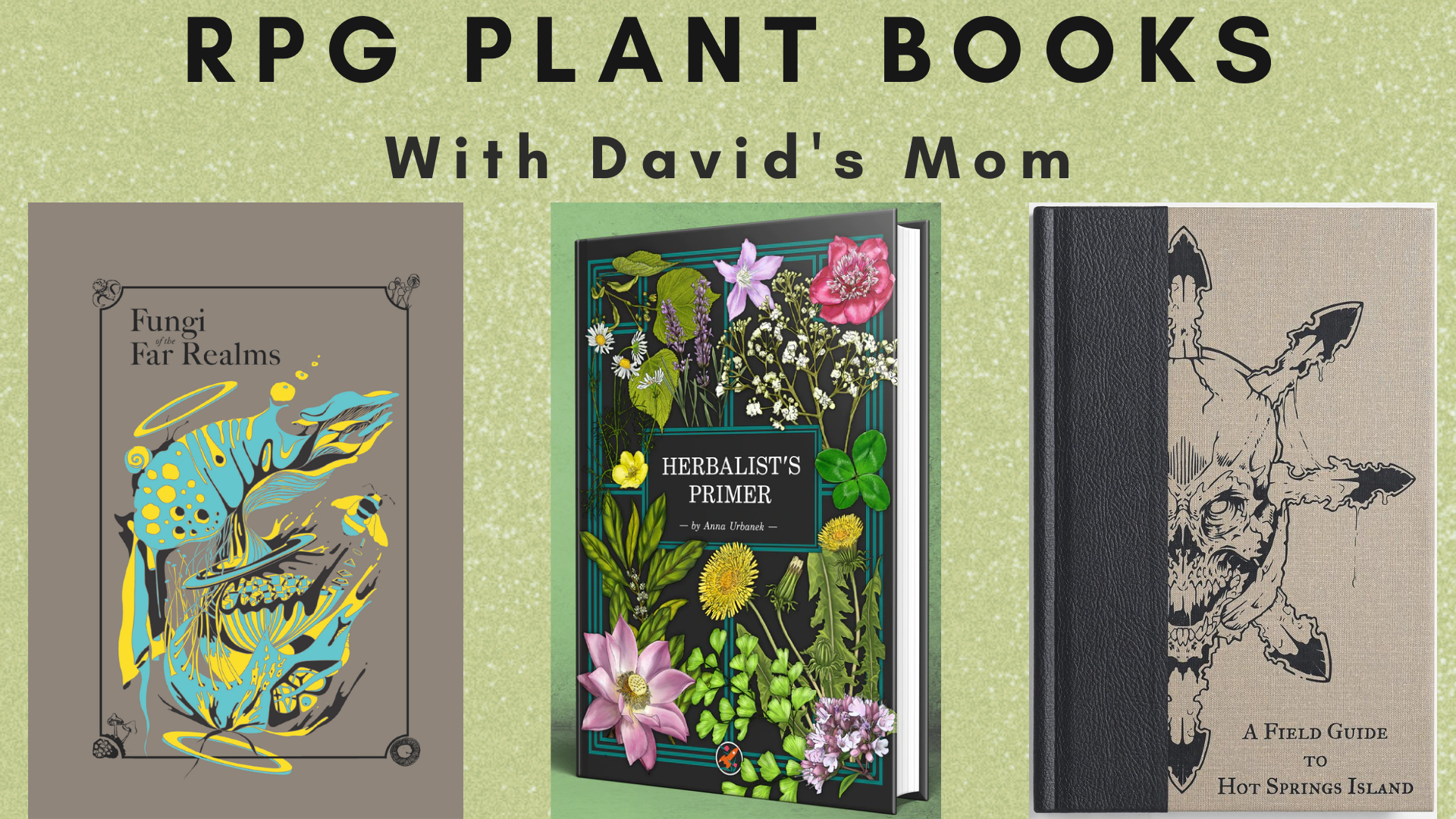
Thanks again to my mother for being so supportive and willing to suffer through a bunch of weird fictional plants. What other RPG plants did we miss?